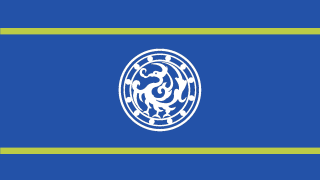Cheonghae
Republic of Cheonghae 청해 공화국 | |
|---|---|
|
Flag | |
| Motto: Beautiful golden sea, mountain, and rivers 아름다운 금수강산 | |
| Capital and largest city | Hanoul |
| Official languages | Korean |
| Recognised national languages | Korean |
| Ethnic groups (2023) | Hannese (85%) Others (15%) |
| Demonym(s) | Hannese(s) |
| Government | Democratic Republic |
• President | Shin Soo-Yeon |
| Legislature | National Assembly |
| Population | |
• 2023 estimate | 85,000,000 |
• 2023 census | 85,203,000 |
| GDP (nominal) | 2023 estimate |
• Total | 4,132,345,500,000 $ (4.1 trillion) |
• Per capita | $ 48,500 |
| HDI (2023) | 0.930 very high |
| Currency | Jeon |
| Date format | mm-dd-yyyy |
| Driving side | right |
| ISO 3166 code | .CG |
Republic of Cheonghae, natively 청해 공화국 - is a democratic country located in the eastern part of the Ochran continent. It borders Yunxia to the south, Untsangasar to the north, and Tsurushima to the east.
Cheonghae was founded in 1892 by replacing the existing nation, the Kingdom of Hwacheon, through the 'Shin Myo Revolution' that was started by its citizens. Cheonghae grew its economy as one of the representative industrial countries of the Ochran continent and is now considered one of the most developed countries in the world.
History
Goverment
The structure of Cheonghae's government is determined by its constitution. Cheonghae's constitution has been revised several times since its enactment in 1895, and today's constitution has been revised in 1993.
Like many democratic countries, Cheonghae's government is composed of a legislative, judicial, and executive branch. The chief executive officer of the administration is the president, who also serves as the head of state. As the head of the administration, the president has executive, military, and diplomatic powers. The president can be impeached if he violates the Constitution, which requires the consent of a majority of the National Assembly and a final ruling by the Supreme Court. The legislature consists of a unicameral system National Assembly. The National Assembly consists of 400 members, who have the power to draft, amend, and enact legislation and the power to revise the Constitution. The Assembly can be dissolved by the president's decision, but in this case, a final ruling from the Supreme Court is required. The judiciary consists of the district court, the high court, and the Supreme Court. The district court and the high court are scattered in each province, but there is only one Supreme Court. The Supreme Court consists of Supreme Court justices recommended by the president and the National Assembly, and the elected chief justice.
